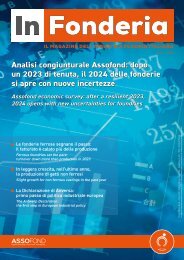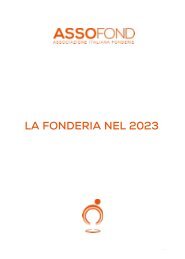In Fonderia 2 2024
Secondo numero del 2024 di In Fonderia
Secondo numero del 2024 di In Fonderia
You also want an ePaper? Increase the reach of your titles
YUMPU automatically turns print PDFs into web optimized ePapers that Google loves.
TECNICO<br />
Materiale<br />
Material<br />
Modulo di<br />
Young (MPa)<br />
Young’s<br />
modulus (MPa)<br />
Tensione di<br />
snervamento<br />
(MPa)<br />
Yield stress<br />
(MPa)<br />
Tensione di<br />
rottura<br />
(MPa)<br />
Tensile stress<br />
(MPa)<br />
Calcolo con<br />
stress residui<br />
Couple<br />
residual stress<br />
Calcolo<br />
con risultati<br />
porosità<br />
Couple<br />
porosity result<br />
A-GGG40 193000 300 420 Si/Yes Si/Yes<br />
B-Alsi10MnMg 73000 200 270 No No<br />
C-Alsi10MnMg 73000 200 270 Si/Yes Si/Yes<br />
Tab. 2 - I dati dei materiali della simulazione.<br />
Tab. 2 - The material data of the simulation.<br />
cessiva per la simulazione delle prestazioni del<br />
getto.<br />
Simulazione CDPE: influenza dei difetti di<br />
colata<br />
Con i risultati della simulazione relativi ai due<br />
processi di produzione visti, possiamo iniziare<br />
ora la simulazione delle prestazioni della parte<br />
per mezzo di Cast-Designer Performance<br />
(CDPE).<br />
Cast-Designer Performance (CDPE), completamente<br />
integrato nell’ambiente utente<br />
Cast-Designer, è un software di progettazione<br />
basato su modelli che usa un’interfaccia intuitiva.<br />
L’utente deve solo seguire le linee guida del<br />
processo passo dopo passo, quindi completare<br />
l’impostazione del modello. È molto potente<br />
e flessibile e di facile utilizzo. Osserviamo che<br />
a differenza dei tradizionali software FEM che<br />
in generale richiedono tempi lunghi di apprendimento,<br />
con CDPE bastano invece poche ore.<br />
L’utente può utilizzare in CDPE lo stesso modello<br />
mesh utilizzato per la simulazione di colata;<br />
il tempo necessario per creare la mesh è<br />
molto ridotto e il processo avviene in maniera<br />
completamente automatica. L’analisi dei risultati<br />
di CDPE è come qualsiasi altro software di<br />
analisi strutturale e viene effettuata all’interno<br />
dello stesso post-processor di Cast-Designer.<br />
<strong>In</strong>oltre, CDPE supporta modelli di grandi<br />
dimensioni e la sua capacità di calcolo in parallelo<br />
consente di ridurre notevolmente i tempi<br />
di elaborazione.<br />
La Fig. 6 mostra il risultato della simulazione di<br />
CDPE, in cui la forza del punzone di prova ricordiamo<br />
essere di 36KN (come Fig. 2). <strong>In</strong> Fig. 6 A<br />
ed A’ sono relativi alla parte in ghisa ricavata<br />
dalla colata in sabbia, mentre B e B’, C e C’ sono<br />
then complete the model setup. It is very<br />
powerful and flexible, also easy to use. For<br />
traditional general FEM software, you always<br />
need a quite longer time to learn, but<br />
using CDPE, a few hours is enough.<br />
The user can use the same mesh model for<br />
CDPE as the casting simulation; the meshing<br />
time could be reduced to minimum and fully<br />
automatic. The result analysis of CDPE was<br />
like any other structure analysis software<br />
and could be read in the same post-process<br />
of Cast-Designer also. More ever, CDPE<br />
support big model size and good parallel<br />
computing capability to save CPU time.<br />
Fig. 6 was the simulation result of CDPE; the<br />
testing punch force was 36KN (as Fig. 2).<br />
A and A’ was the iron part made by sand<br />
casting, B and B’, C and C’ was aluminum<br />
part made by high pressure die casting, but<br />
B and B’ did not couple the manufacture defects<br />
while C and C’ considered the residual<br />
stress and porosity affection. The Damage<br />
Crack Criteria (DCC) could be used to evaluate<br />
the safety of the casting part in difference<br />
applied force. The DCC was calculated<br />
as the following formula. As we know that<br />
maximum shear stress at a point in the material<br />
will be equal to the half of difference<br />
between maximum and minimum principle<br />
stress and therefore, we will have following<br />
equation.<br />
τMax = (1/2) x (σ1- σ3)<br />
Let us determine the value of shear stress<br />
corresponding to the yield point of the material.<br />
<strong>In</strong> case of simple tension, Stress will be<br />
available in one direction only and therefore<br />
at elastic limit, principle stresses will be σt,<br />
0 and 0.<br />
90<br />
<strong>In</strong> <strong>Fonderia</strong>














